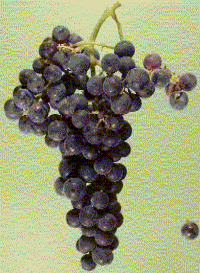|
Merlot
|
The Merlot grape is
a close cousin to
Cabernet Sauvignon in many
respects. It is lower in tannins and makes wines that
mature faster and are softer in texture. Merlot is
often blended with Cabernet Sauvignon in order to soften
the blend. At its best, Merlot makes a wine that is dry,
rich in flavor and smooth as it finishes in your throat.
At its worst, Merlot makes wine that is dry but thin in
taste and texture, and not very pleasant to consume. Most
of what you will come across are likely to be of pretty
good quality.
|
|
|
Merlot is able to mature
in regions that are cooler than those required for Cabernet
Sauvignon. Merlot is more susceptible to fungus and
mold diseases and therefore a bit harder to grow. Merlot
varies widely in quality around the world depending on location
and producer. This variety was first known for its success
in the Saint
Emilion and Pomerol areas of Bordeaux.
Chateau
Petrus is the stellar example of fine Merlot.
|
|
Merlot usually has ripe berry
components in the bouquet. Its wines tend to be soft,
fruity and smooth in texture. Select Merlots can have
long aging potential but most are ready to consume in 4
to 8 years. Merlot is usually bottled in a Bordeaux (high
shouldered) bottle.
|
|
Merlot is enjoying a surge
in popularity and additional acreage is being planted in
many major producing regions. It came to California
in the mid-1860s and has become one of the most popular
wines since its surge in popularity in the 1990s.
|
Merlot should be served slightly
below room temperature. When alcohol reaches 74 degrees
F., it is likely to cause an unpleasant sharpness in the
taste. Cooling the bottle for 15 or 20 minutes (but not
much longer) in a refrigerator can be a good way to reach
the desired serving temperature.
|
